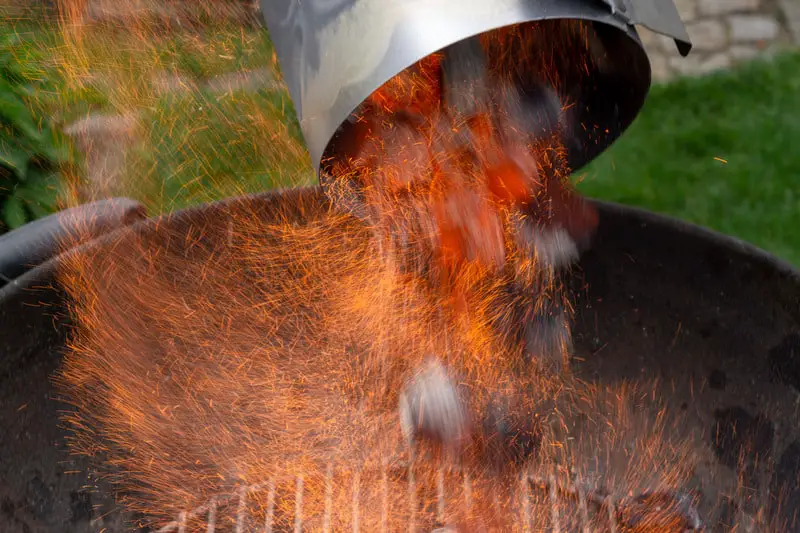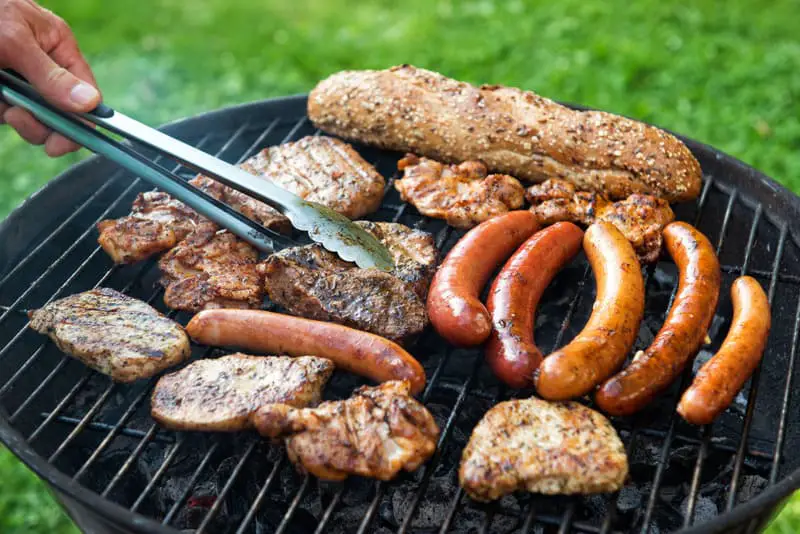For some, grilling with charcoal is intimidating. Gas grills tend to be easier to use because they have a steady flame and you don’t have to add fuel as you cook.
But food cooked on a gas grill just doesn’t have that same flavor that you get when using a charcoal grill.
But, if you’ve never used a charcoal grill before, you’re probably wondering how to get started. In this article, we’ll tell you how to use a charcoal grill for beginners, step by step.
We’ll go over the best kind of charcoal to use (lump or briquette), how best to light the coals, how to arrange them, how to know when your food is done, and how to extinguish the coals when you’re finished. Plus, everything in between.
Look no further for the answers to all your charcoal grill questions.
Want to see some amazing charcoal grills and accessories we like? Check out these articles:
- 13 Best Charcoal Grills Under $200: These Grills Are Amazing!
- 49 Must Have Grill Accessories You Need at Your Disposal
Grilling Supplies
Before we get into the step-by-step process of using your charcoal grill, let’s talk about the supplies you need.
You don’t want to light your coals and then realize that you have to run to the store for something. So, make sure you have everything you need before you start the process!
For this, we’ll assume that you already have the most important part: the charcoal grill. If not, definitely check out the Weber Original Kettle.
- Your purchase includes One Weber Original Kettle…
- Grill dimensions: Lid Closed – 42.9″H x 27″W x 33″D |…
- One-Touch cleaning system with high-capacity ash…
- Slide the lid into the Tuck-Away lid holder on the side…
It’s by far one of the most popular charcoal grills on the market, and for good reason. It’s super versatile, easy to clean, and has lots of neat features that you just won’t find on many other grills of this price point.
But regardless of what grill you have or which grill you plan on buying, it’s a good idea to read your owner’s manual and familiarize yourself with your grill thoroughly.
Charcoal
There are many different brands of charcoal out there, but really only two different kinds: lump charcoal and briquettes.
There’s one main difference between the two: lump charcoal is all-natural and made from burned wood, whereas briquettes generally have some sort of additives that bind them together and help them burn consistently.
Most briquettes also have burned wood by-products in them, but it is possible to find natural briquettes if you really look.
However, if you ask a handful of regular grillers, half of them will prefer lump charcoal and the other half will prefer briquettes. It’s all a matter of preference.
Lump charcoal lights quickly, burns faster, and is more expensive. Briquettes, on the other hand, are cheaper, burn longer, and are slower to light.
We suggest trying each kind out to see which you like best. But whatever you do, don’t purchase ‘easy light’ briquettes with chemical additives. These tend to make your food taste a little funny!
Charcoal Chimney Starter
Investing in a charcoal chimney starter is a purchase that few grillers regret.
- Designed to quickly produce hot coals for cooking
- 7.5 in. In diameter, 13 in. High
- Specialized cone-shaped grate
- Durable construction for longevity
This ingenious invention makes it super easy to light your charcoal. After 15 minutes you’ll have a nice bed of coals ready to go, whereas without a starter you’ll have to wait 30 minutes, at least.
But, we’ll also discuss how to light your coals if you don’t have a chimney starter.
Other Supplies
A few other basics you should have on hand:
- Grilling Tongs and Spatula
- 2 in 1 Meat and Grill Thermometer
- Heat-Resistant Grilling Gloves
- Grill Brush
Step 1: Prepare Your Grill
Here are a few things you want to do before you light your charcoal. Taking these steps before you begin grilling will allow you to make the most of your grill and your coals.
Clean Out The Ash
Make sure you don’t have ash built up at the bottom of your grill. Ash can block air from getting to your coals and allowing you to get a good fire going.
Open Your Vents
Since fire needs oxygen to thrive, it’s a good idea to open any vents on your grill. Usually, there’s a vent in the lid and one near the bottom of your grill. You can adjust these vents later as you need, but for starting the initial coals on fire, you should have them open.
Determine How Much Charcoal You Need
How much charcoal you need will depend on the type of charcoal you’re using, how much food you’re cooking, what kind of charcoal formation you’ll be using, and how long you estimate the food will take.
For most grills and most food, you’ll want to start with somewhere between 50 and 100 briquettes. If you’re grilling high-heat stuff like burgers, you’ll probably want to be on the higher end.
On the other hand, if you’re slow-cooking a bird or a roast, you’ll probably want to start off with 50 or so briquettes. You don’t want to put these in your grill yet. You just want to have an idea of how many you’ll be using.
Step 2: Light Your Coals
If you’re using a chimney starter you’ll want to follow the directions for your particular model.
Usually, it’s as simple as filling the starter with charcoal, adding some paper underneath the coal bin, lighting the paper with matches or a lighter, and letting it sit.
If you don’t have a chimney starter, you can use lighter fluid to get your charcoal lit, but only if you’re willing to deal with the possibility that the chemical taste of the lighter fluid may end up in your food.
If you’d rather start your coals without lighter fluid or a chimney starter, just follows these steps:
- Twist some paper into a small donut shape, leaving a hole in the middle.
- Coat the paper in a small amount of cooking oil then place paper on your charcoal rack.
- Light the paper on fire and place a single piece of charcoal on top of it.
- Once the charcoal begins to develop ash on the bottom, flip it over to light the other side.
- Once both sides of the charcoal are burning, add a few more pieces around it. The initial piece of charcoal should light the others.
- Keep adding charcoal until you have the amount you need.
- Close the lid on your grill and wait for 20 to 30 minutes, or until most of the charcoal has developed a layer of white or gray ash on the outside.
Note: If you’re having a hard time lighting the charcoal with just a piece of paper, you can use some small sticks to keep the fire going longer. Coat some twisted paper with cooking oil, add sticks to create a small fire, then add 2 or 3 pieces of charcoal. You should then have the start of your coals.
Step 3: Place Your Coals and Let Them Sit

If you’re using a starter chimney you can pour the coals onto your charcoal grate or firebox whenever you see that all of the coals are glowing nicely or have a thin layer of ash.
If you need more charcoal than could fit into the chimney starter, you can carefully add the unlit charcoal on top of the lit ones, or you can put the lit coals on top of the unlit ones.
For the fastest results, carefully place the unlit charcoal on top of the coals after you’ve poured them out of the chimney starter.
If you used another method to light your coals, you can simply add as many as you need until you have the correct amount. Just be careful not to place them too close together, as they need airflow between them to light.
While you’re waiting on your coals to develop a layer of white or gray ash on the outside, close the lid to your grill and make sure to keep the vents open. Let it sit for 10 to 20 minutes.
This does 2 things:
- It lets the coals light evenly and get to temperature.
- It preheats your grill and helps to burn away any germs or stuff you wouldn’t want to touch your food. This, however, shouldn’t take the place of proper grill cleaning and maintenance as outlined by your owner’s manual.
Once the majority of your coals have the tell-tale white or gray ash, and your grill has been preheated to your liking, you can move on to the next step: grilling your food!
Step 4: Grill Your Food
Once your coals look good and your grill has been preheated, you can start adding your food. You want to keep your meat thermometer handy so you can tell when the food is done. Depending on what you’re cooking, you may need to add a handful of charcoal every half hour or so.
If your grill has a built-in thermometer, it can come in handy here. If you don’t have one, it’s a great idea to invest in a thermometer for your grill like the one mentioned above.
Once the food is on the grill you can check the temperature occasionally. You don’t want to open the grill unless you have to, because it lets a lot of the heat out when you do. This is especially important when you’re slow-cooking with indirect heat.
Step 5: Make Adjustments As Needed
While you’re grilling, make adjustments to the vents and the charcoal as needed. Open vents mean higher temperatures, whereas closed vents mean lower temps.
If you need to add charcoal, you don’t want to wait until your coals are almost gone. The last thing you want is to have to light the coals over again, so remember to keep an eye out and plan ahead when it comes to adding charcoal.
Step 6: Enjoy!
Once your food has reached the correct temperature, it’s time to eat! Remember that food tends to cook for five minutes when removed from heat, so take that into account when you’re using your food thermometer to determine when to remove the food from the grill.
Step 7: Scraping The Grates & Cooling Your Coals
The best time to clean the cooking grates with a brush is when the grill is still warm. This makes it easier to remove any food residue and keeps the grill in good condition.
As for cooling down the coals, by far the safest option to handle a hot grill is simply to wait. You can close the lid and shut all the vents to starve the coals of oxygen.
If you absolutely must put your coals out quickly, water is an option, but beware that the sudden temperature change that occurs when you pour water on hot coals can damage parts of your grill.
To avoid this you can attempt to use lukewarm water, but there is no guarantee that it won’t damage the grill. If you do use water to extinguish the coals, watch out for hot embers that can become airborne when you spray or pour water on the grill.
If your grill’s manual has suggestions for extinguishing the coals, it’s best to follow those. Otherwise, simply wait until the coals have cooled.
In Conclusion
Now you know the best way to use a charcoal grill, step by step.
If you’re new to grilling, don’t be surprised if it becomes more than just a way to cook food. For many of us it’s a way of life! There’s little better than enjoying the wonderful weather while chowing down on a nice plate of barbecue.
Thanks for reading. Stay safe while you’re grilling!



